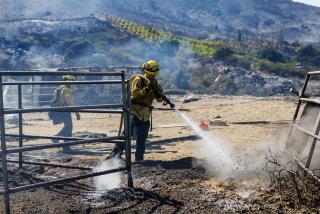Super Scooper Planes Win Officials’ Praise in Rocky Debut : Firefighting: Gusting winds force the water-dumping aircraft to fly higher than optimum altitude. Even so, they are called effective.
The much-heralded Super Scooper firefighting planes ran into trouble trying to fight the Malibu blaze Thursday, their first major test against classic Southern California fire conditions of strong winds hurling flames over forbidding mountain slopes.
Still, fire officials said they were pleased with the performance of the planes.
“The 35 to 50 m.p.h. winds affected the dropping capabilities,” said Los Angeles County Fire Department Capt. Steve Valenzuela. Because the winds and terrain made it difficult to fly close to the fire-ravaged slopes, the pilots “had to drop from a higher altitude, which ended up causing the water to turn into a finer mist before hitting the fire,” he said.
But Valenzuela said the two planes were nonetheless effective in helping to contain the fire by dropping water during the blaze’s early moments and working with the department’s seven water-dropping helicopters, which were able to fly lower and score more direct hits.
County Fire Chief P. Michael Freeman said the planes were more effective than they appeared. From along Pacific Coast Highway he watched one of the planes make a drop--and, at first, was startled to see the water appear to evaporate in the gusty winds.
“But as it dropped alongside and across PCH,” Freeman said, “it was like being in a downpour of rain, which tells you that although the water dropped may appear to dissipate, it still has a significant cooling and wetting effect.”
*
In ideal conditions, the planes can drop water from 150 feet above the fire. But in Latigo Canyon’s steep terrain, the planes were often forced to fly 150 feet above ridge crests--while the fire burned 200 feet or more down the hill. That meant that the water had to fall 350 to 400 feet before reaching the target, Freeman said.
One veteran firefighter on the scene was unconvinced of the planes’ capabilities. The Super Scooper, he said, obviously has to fly high enough to clear the crest of the mountains. On a windy day such as Thursday, that means the water can blow a quarter- to a half-mile away from the target.
It was unclear Thursday night how many runs each of the Super Scoopers made, but Freeman said there were at least 12 drops--each about four times the size of a helicopter load.
Although the Super Scooper pilots were able to use the ocean for water pickups, Freeman said, the high winds forced them to make a slight detour two miles up the coast to Paradise Cove. On a calm day, the planes could have scooped water within sight of the blaze.
The county Fire Department acquired the two Canadian-made aircraft in October on a three-month lease from the Quebec government.
In an unusual partnership, the county shared the cost of leasing one of the planes--$719,000, including two crews and mechanics--with the California insurance industry and the federal government. The other plane is being donated for three months by Bombardier Inc. of Montreal, parent company of Canadair, which manufactures the planes.
*
Each plane costs $515 an hour to fly. Buying a plane outright would cost $16.5 million. The two are based at Van Nuys Airport.
The high costs are among the reasons that critics blocked extensive testing of the planes here more than a decade ago. They had also argued that the planes cannot fly at night, have trouble in gusty winds and cannot refill from a choppy ocean.
But last fall’s two dozen wildfires and their $1-billion price tag spurred the county to become the first California jurisdiction to acquire the planes.
More to Read
Sign up for Essential California
The most important California stories and recommendations in your inbox every morning.
You may occasionally receive promotional content from the Los Angeles Times.










